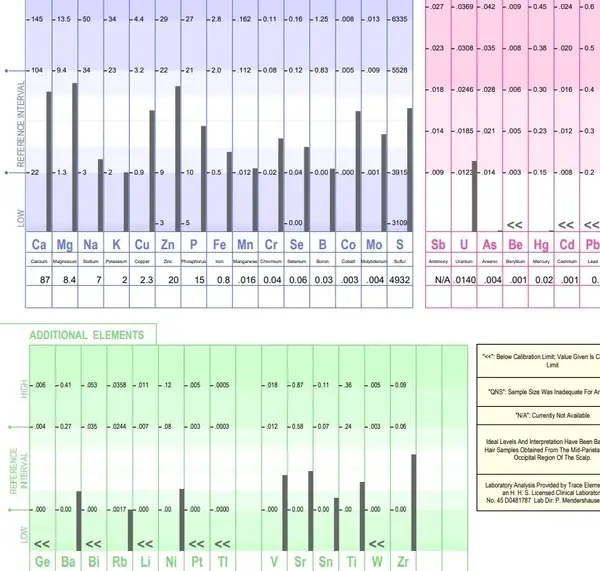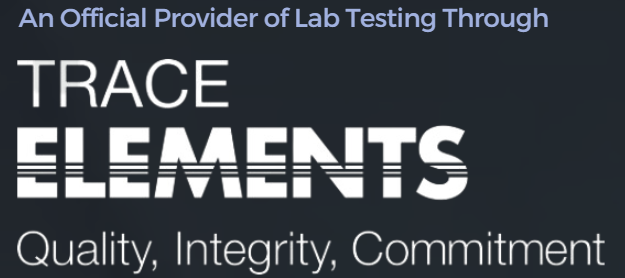Blood offers many essential medical health markers, and so it most certainly has its purpose for testing. However, when it comes to determining one’s mineral or heavy metal status, relying solely on blood is, stated quite bluntly, a half-blind approach. A key concept, so simple and yet so vastly overlooked by many practitioners, is that the nature of blood is homeostatic, always working to return itself to a normal range. It does this at the expense of cell and tissue levels. This is why, all too commonly, even when patients are struggling with symptoms, their blood labs come back “within range”. The doctor tells the patient their levels are fine, and the patient is left without answers. Yet, almost inevitably, the patient may have significant depletions of metals at the cellular level, or have toxic metals piled up in their tissues.
The fact that people have become so conditioned to relying on blood testing is a major reason why the concept of widespread mineral deficiencies and toxicities remains so misunderstood – together with many of the symptoms which result. (The www.MineralMastery.com course was designed to bring this education forth). The epidemic of copper toxicity, for example, explained at www.coppertoxic.com and taught further within the Mineral Mastery course, more often than not is not seen in blood, yet is much more likely to be picked up through Hair Tissue Mineral Analysis. Consider, for example,
“The total serum or plasma copper concentration is generally insensitive to detection of copper overload” [Source]
A similar problem exists with testing serum magnesium – the standard test most commonly done to assess a person’s magnesium status. To be very clear, a ‘normal’ serum magnesium level does not in any way rule out the possibility of magnesium deficiency which can typically be picked up through HTMA. For one, serum regulates itself at the expense of cellular status. Second, some labs have altered their reference ranges based on declining magnesium levels across the population, making what would be considered a low level in the past seem acceptable today. Third, only 0.3% of the body’s total magnesium is even found in the blood serum, and yet this is the standard of testing that most doctors rely on! Consider further:
“The tight control of magnesium serum levels… serves as a poor proxy for the 99.2% of magnesium in other tissues that constitutes the body’s true magnesium status. Furthermore, this narrow serum range feeds the common perception of clinicians that magnesium levels rarely fluctuate… This contributes significantly to magnesium deficiency not being recognized as a modifiable nutritional intervention, and magnesium in general, being the neglected mineral that it is. [Source]
Consider also that blood fluctuates hourly, and can be thrown off by something as simple as what you ate for breakfast that day. The irony cannot be overlooked that those who are quick to dismiss the accuracy of HTMA (a test which shows these imbalances when blood often will not), are often the same people who promote blood as being a superior and reliable measure of accuracy.
Again, as the concept is so vital for people to understand:
“The transport system of the blood absolutely does NOT provide a reliable correlation of tissue mineral levels at the cellular level.” ~Rachel Neumann
This is why, if we truly want to gain a better understanding of mineral imbalances (and toxic metals) and their impact on health, we must consider the cellular and tissue levels. Often though, people who dismiss HTMA do so based on their own lack of training in HTMA interpretation, or they’ll reference one of the two studies done in 1985 and 2001, (both published in the Journal of the American Medical Association), unaware of the history of those studies. Those studies violated most all acceptable protocols for collecting and testing the hair samples, while also painting the findings in a way as to suggest HTMA as being unreliable. Yet, for those who took the time to analyze the actual data buried in the results in a way most untrained eyes wouldn’t pick up on, the hard data from the two leading labs (TEI and ARL) showed clear patterns and an accuracy of .999%. The author of the first study was later found by the California Appeals Court to be “biased and unworthy of credibility”, yet this individual continues to run various websites that discredit HTMA (and numerous other natural health practices) by calling it ‘quackery’. Such websites however carry great influence over the unsuspecting public. Unfortunately, when people do a Google search and they come across those sites or phrases such as ‘quackery’, they fall for it. As a result of this, trust in HTMA has been damaged, while also impeding the advancement of mineral-based nutrition and health awareness that otherwise could be benefitting so many more people.
Dr. David Watts, founder of Trace Elements Inc, addresses many of the specific false accusations made by the aforementioned study author in his article here. At the end of his article, he makes a point well worth considering:
HTMA is the most accurate method available as a nutritional screening tool. Perhaps if it was being used as the basis to prescribe drugs, it would be more readily embraced by traditional allopathic medicine.” ~Dr. David Watts, Ph.D.
While HTMA is not a panacea, when properly tested and interpreted it provides a wealth of information that would be nearly impossible to gather through blood (or urine) testing alone. Not to mention, the mineral imbalances that hold the key to addressing some of today’s most common health conditions can often be easily seen through HTMA, whereas through blood they would not be picked up. Across thousands of patients in clinical practice, I can’t count the number of times a patient has come to me having been previously told by either their allopathic or alternative medicine practitioner that they “don’t have copper toxicity” or some other metal imbalance based on the testing previously performed. Of course, regardless of the type of test, proper interpretation is essential., and this is especially true for HTMA. This brings up 4 important caveats that people should consider when ordering…
4 CAVEATS WHEN ORDERING THAT HAVE LED TO CONFUSION OVER HTMA VALIDITY
- The lack of regulation amongst those who offer HTMA means many who provide the service of HTMA (or what they market as ‘hair analysis’) have very little training or experience in how to interpret the charts. [This Link provides general considerations of things to look for when deciding on a qualified HTMA practitioner].
- Not all “Hair Analysis” services are the same! There are NUMEROUS types of tests that all use the term “Hair Analysis”, yet not all are properly suited for the purpose of mineral balancing or understanding copper toxicity. Some tests are more focused on toxic metals and limit the mineral levels being tested, some labs use a chemical procedure to wash the hair sample (altering certain minerals), some use bioresonance or other technology to detect “food intolerances”, some rip out a single hair follicle and beam it across the ocean and you get a beautiful report magically delivered to you 10 minutes later! People need to understand that not all HTMA is equal, and this adds to why some will argue that HTMA is not accurate when they send samples to different labs and get different results. Likewise, when you find some discount service on Amazon, for example, you typically get what you pay for. It’s important, for the purpose of mineral balancing and detoxing, to work with the original leaders in this field – those being Analytical Research Labs (ARL) and Trace Elements Inc (TEI) respectively. The accuracy and consistency of results between these two labs is over 99%.
- Most ‘discount’ HTMA services simply provide the chart results, or sometimes an automated lab report alongside. In so many cases, I see people feeling lost afterward and reaching out in need of further interpretation, feeling more confused than ever. Charts at face value are so easily misinterpreted, and automated lab reports fall far short in terms of personalized guidance. Likewise, those who write about HTMA not being valid because they compared a blood level to a hair level and found differences are not understanding that (a) tissue levels are different than blood and (b) HTMA levels are not meant to be read at face value! HTMA is complex, and requires proper human interpretation by a well-trained practitioner to understand the results. It is not a test to be read at face value. Unfortunately, when some health ‘expert’ or blogger claims HTMA is not valid,it’s more so a reflection of their own ignorance or lack of training in this field rather than a shortfall of the test itself (assuming the test is performed by a qualified lab).
- Added to all this, one of the most prominent ‘schools’ of HTMA / nutritional balancing, under which many other practitioners have studied HTMA, infuses conspiratorial views of politics, spirituality and religion into their programs… aspects which completely detract from the true science behind mineral balancing.
These factors of course do not help the overall reputation of HTMA. The science behind authentic HTMA is based on factual biochemistry, and learning proper interpretation of HTMA charts is complex and takes years of dedicated study. This underscores the importance of working with a proper lab, the right type of hair analysis, and an experienced practitioner well-trained in HTMA. (Our annual HTMA Virtual Summit brings together pioneers and leaders in this field to provide education and help re-establish and maintain the integrity of authentic HTMA and mineral-based health science).
The use of prescribed clinical quality control, including method validation, proficiency testing, split sampling, and good laboratory practices clearly demonstrates that measuring trace elements in hair can be analytically valid. [https://pubmed.ncbi.nlm.nih.gov/11703167/]
A further benefit of HTMA is that it shows the relationships between minerals. Even if a mineral level looks ‘ideal’ (whether blood, HTMA or other test), it also needs to be considered in relation to other minerals (magnesium in relation to calcium for example, or copper in relation to zinc). Understanding these relationships provides additional insight into both physical and psychological health reactions that are typically missed when looking at blood labs or minerals in isolation.
This also highlights one of the problems with chelation therapy. Not only is chelation therapy not necessarily the safest approach when metals are being forced out via the kidneys (not to mention some of the side effects inherent with certain chelating agents), but a vacuum is then created in the body. Metals and minerals have specific relationships, and short of an acute metal exposure/toxicity, a deficiency of a partcular mineral opens the door to greater retention of corresponding metals. Often, the metal is retained by the body as a short-term protective mechanism due to an underling mineral deficiency (such as with mercury and zinc for example). A vacuum is then created by chelating out mercury without first restoring zinc. I recall a case of a lady who had spent 2 years under the chelaton guidance of one of the top mercury chelation ‘protocols’. She came to me in extremely poor health. After 2 years of her trying professional chelation, we did an HTMA test and not only did it reveal the highest mercury levels I’d ever seen, but more importantly, she had an extremely low zinc level which had never been picked up in any of her other testing. Such vitally important relationships are best seen through properly interpreted HTMA. HTMA data provides a roadmap for safer natural detox by providing the essential nutrients needed by the body in order to allow the release of the toxic element.
Similar is true for copper too. Some practitioners just want to chelate out copper. There are certain times when chelation may be needed, but for most people, addressing a copper issue is never just about chelating out copper! An intelligent approach must consider supporting the various detox pathways, supporting the bio-availability of copper, and addressing the various mineral imbalances (at the cell and tissue level) that the excess copper has created. Once again, these cell and tissue imbalances are best understood through properly interpreted HTMA. Addressing the epidemic of copper toxicity and supporting further awareness of this important mineral imbalance is only hindered when HTMA is dismissed, or not properly utilized.
A mother should not have to collect her dead daughter’s hair sample at the morgue because her doctor had convinced her she was fine and healthy. In this real-life case, the post-mortem HTMA revealed an extreme copper toxicity condition in the daughter. Sadly, her doctor had dismissed copper toxicity as not being a concern, and encouraged her not to have an HTMA because he didn’t feel it was a valuable test. Frankly, such ignorance is inexcusable.
Blood shows what’s circulating in your blood at the very moment you do the blood draw. As such, levels can easily be affected by diet that day, hypoxia, etc. Plus, as mentioned, blood has almost no correlation to stored tissue levels. The HTMA on the other hand provides a window into approximately the past 2 or 3 months, together with showing the all-important relationship between the minerals as mentioned above. Let’s say, for example, the body was mobilizing high amounts of copper 3 weeks ago, but no longer is. A blood test today would likely show normal copper and, based on that, the underlying copper toxicity condition would be missed. On the other hand, the HTMA has a much higher likelihood of picking up that mobilization because it’s averaging the results over an extended period of time – in addition to showing the broader mineral profile which is really where the evidence for copper toxicity is seen.
Blood has an advantage when the detox focus is more myopic, monitoring levels on a more daily / hourly basis. This can be especially useful when a forced mobilization is occurring, and/or with chelation. If you’re trying to monitor the details of what’s circulating moment by moment, blood outshines HTMA. However, when wanting to understand the relationships between minerals and metals in the body – the bigger picture – together with understanding how these imbalances can influence both physical and mental health reactions, HTMA offers a powerful screening tool.
Again, the HTMA provides a roadmap for safer detoxification, and provides intelligent guidance on the specific nutrients that need to be emphasized in order to safely and naturally mobilize metals and support the rebalancing of the body.
“HTMA is the best lab tool to detect copper toxicity and its effect on the broader nutrient mineral pattern that is related to both physical and mental health.” ~Dr Malter, PhD
“Hair mineral analysis is an established technique and laboratory procedure, and most importantly research to support findings are highly reliable. …As a screening test, it is able to provide indications of imbalances, deficiencies and excesses of many essential and toxic minerals and can provide a comprehensive picture upon which to base the most effective nutritional therapy.” (Source)
In conclusion, a properly interpreted HTMA tends to reflect much better the extent of magnesium deficiency across the population. It tends to far better reflect the extent of widespread cellular deficiencies of potassium as well – this is almost never seen in blood testing as potassium deficiencies in blood don’t often show up until the 11th hour of illness. As for copper toxicity, consider that this silent epidemic remains vastly unrecognized, in part because excess copper gets stored in tissue, not blood. Most studies, of course, are based on blood. Meanwhile, many practitioners have inadequate training in HTMA to fully understand its usefulness or application, and instead tend to dismiss it. While having data available from various types of tests can always help create a more complete picture, often people are encouraged to spend thousands of dollars on various tests before they end up finally discovering HTMA – a test that often, for a fraction of the cost, can reveal key factors behind their health concerns. When it comes to copper toxicity especially, countless lives could surely be saved if hair analysis was more readily available and accepted.
Bottom line, if you’re wanting to know which nutrients your body needs more of, the HTMA can offer far more guidance than any blood or urine test can. Time after time across the thousands of clients I’ve personally worked with, I have people come to me with various symptoms whose blood tests showed ‘normal’ but yet through HTMA, very often, their symptoms can be easily explained.
For further reading, this article explains the high accuracy of properly conducted HTMA and the history behind some of the ‘attacks’ on HTMA which still today negatively influences public opinion. Additional education on the importance of HTMA and supporting health through mineral balancing is taught in the www.MineralMastery.com course for those seeking a deeper understanding. Additionally, a long list of references supporting the use of HTMA in the research and healthcare fields is available here: https://www.traceelements.com/EducationalResources/HTMA.aspx







